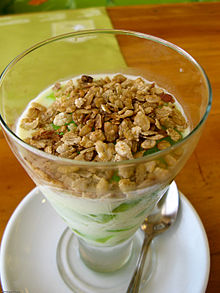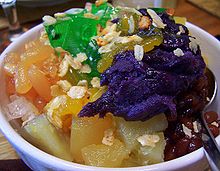User:Obsidian Soul/sandbox/Pinipig
| This is not a Wikipedia article: It is an individual user's work-in-progress page, and may be incomplete and/or unreliable. For guidance on developing this draft, see Wikipedia:So you made a userspace draft. Find sources: Google (books · news · scholar · free images · WP refs) · FENS · JSTOR · TWL |
 | |
| Alternative names | Dudomén, Tsu-om, Du-om |
|---|---|
| Course | Appetizer, Garnish |
| Place of origin | Philippines |
| Serving temperature | room temperature |
| Main ingredients | Glutinous rice |
Pinipig is a rice dish from the Philippines. It is made by pounding immature green glutinous rice kernels resulting in a crispy texture when roasted.
It is widely used as garnishing for traditional desserts in Philippine cuisine.[1]
Description
[edit]Preparation
[edit]Taste and texture
[edit]Pinipig has the consistency
History and cultural importance
[edit]
Pinipig is traditionally used as a garnish for desserts like kalamay, espasol, and nilupak.[1][2][3]
Etymology and nomenclature
[edit]Pinipig is known as dudomén in Ilocano.[4] Among the Igorot people, pinipig is known as tsu-om or du-om.[5]
A similar dish in Vietnam is known as Cốm.
See also
[edit]References
[edit]- ^ a b Dela Cruz; et al. (2007). "Native Delicacies". Learning and Living in the 21st Century. Rex Bookstore, Inc. p. 162. ISBN 9789712347870.
{{cite book}}: Explicit use of et al. in:|author=(help) - ^ Lynda B. Valencia (1985). "Kakanin for Christmas Simbang Gabi". In Angelita D. Romero & Rene C. Romero (ed.). Developmental Reading: A Skill Text for College Students. Rex Bookstore, Inc. p. 89. ISBN 9789712302299.
- ^ Dagoon; et al. (1999). Culinary Arts I. Rex Bookstore, Inc. p. 269. ISBN 9789712326035.
{{cite book}}: Explicit use of et al. in:|author=(help) - ^ Carl R. Galvez Rubino (2000). Ilocano dictionary and grammar: Ilocano-English, English-Ilocano. University of Hawaii Press. p. 172. ISBN 9780824820886.
- ^ Donald Daryl Ayochok Daoey. "Tsu-om/Du-om". Igorot Food Exotica. Retrieved July 5, 2011.

